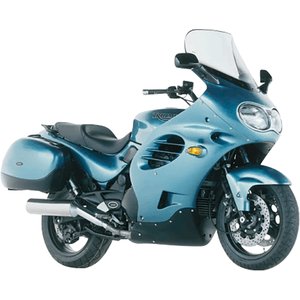Triumph Trophy 1200 (1996–2003): A Touring Icon Revisited
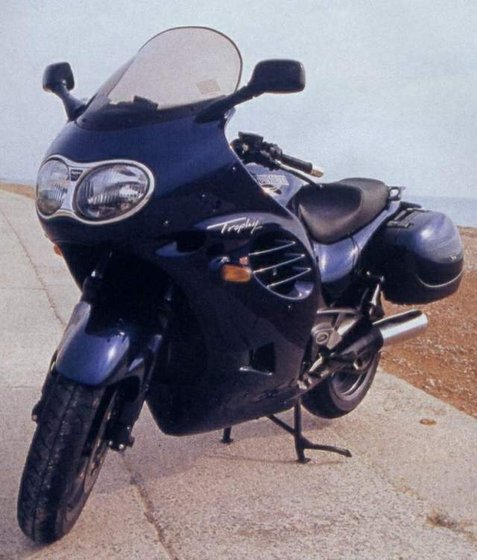
Introduction
The Triumph Trophy 1200, produced from 1996 to 2003, remains a benchmark in the sport-touring segment—a machine that blends British engineering charisma with relentless long-distance capability. Designed to devour highways while coddling its rider in comfort, this inline-four powerhouse carved its niche in an era dominated by Japanese and German rivals. Having spent a week with a meticulously maintained 1999 model, it’s clear why the Trophy 1200 still commands respect among touring enthusiasts. From its muscular engine to its thoughtfully designed ergonomics, this bike is a time capsule of 1990s ambition—one that holds up remarkably well today.
Engine Performance: Smoothness Meets Muscle
At the heart of the Trophy 1200 lies its 1,180 cc liquid-cooled inline-four engine, a configuration that delivers 108 HP (78.8 kW) at 9,000 RPM and a meaty 104 Nm (76.7 lb-ft) of torque peaking at 5,000 RPM. These numbers translate to effortless acceleration, whether you’re merging onto a freeway or overtaking slower traffic on winding mountain roads.
Key Highlights:
- Torque for Days: The Trophy’s torque curve is its party trick. At just 5,000 RPM, it delivers 76.7 lb-ft of twist, meaning you rarely need to downshift for passing power.
- Silky Smooth Operation: Even at 70 mph (113 km/h) in sixth gear (3,800 RPM), vibrations are minimal—a rarity for carbureted bikes of this era.
- Six-Speed Transmission: The gearbox is robust, though shifts require deliberate footwork. The chain final drive is reliable but demands regular maintenance—a small trade-off for its direct power delivery.
During my test ride, the engine’s character revealed itself fully. Rolling on the throttle at 4,000 RPM in third gear launched the bike forward with a linear surge, accompanied by a muted growl from the exhaust. It’s not a fire-breathing sportbike, but it doesn’t pretend to be. Instead, it offers a refined, stress-free experience ideal for covering continents.
Ergonomics and Comfort: Built for the Long Haul
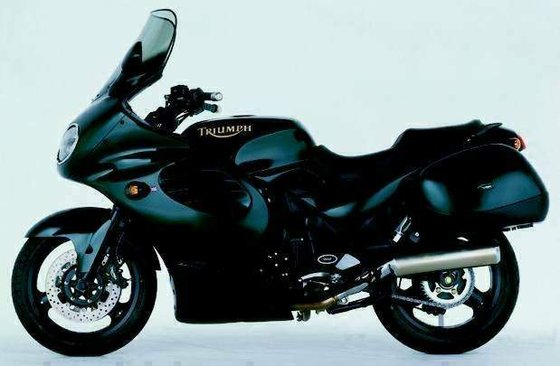
Touring motorcycles live or die by their comfort, and the Trophy 1200 excels here. The 31.1-inch (790 mm) seat height accommodates most riders, though the narrow perch can feel unforgiving after hours in the saddle. The solution? An aftermarket seat—a popular upgrade among owners.
Notable Features:
- Wind Protection: The full fairing deflects windblast effectively, though taller riders might experience buffeting around the helmet. A taller windscreen (readily available at MOTOPARTS.store) solves this.
- Integrated Luggage: The 45-liter panniers swallow a full-face helmet and then some. Color-matched to the bike’s paint (Emerald Green on my test unit), they add practicality without sacrificing style.
- Glove Boxes: Two lockable compartments in the fairing stash sunglasses, toll coins, or energy bars—a touch of convenience that modern bikes often overlook.
The riding position is slightly leaned forward, with wide handlebars offering leverage for low-speed maneuvers. At 518 lbs (235 kg) dry, the Trophy feels substantial at a standstill but sheds weight once moving. The center stand—a godsend for maintenance—makes lifting the bike effortless with its fold-out handle.
Handling: Confidence on Twisty Roads
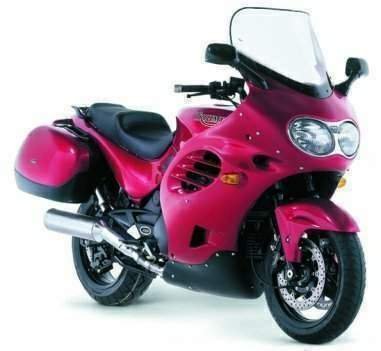
Don’t let the Trophy’s touring pedigree fool you. The steel trellis frame and 43 mm adjustable forks (compression, rebound, preload) give it surprising agility. With a 27-degree rake and 4.1 inches (105 mm) of trail, it strikes a balance between stability and flickability.
On the Road:
- Highway Stability: Crosswinds nudge the bike gently, but it never feels unsettled. The Bridgestone Battlax tires (120/70-ZR17 front, 170/60-ZR17 rear) provide ample grip, even when loaded.
- Cornering: Push hard into a bend, and the Trophy responds with neutral steering. Ground clearance is generous—only aggressive lean angles scrape the pegs.
- Braking: Dual 310 mm front discs with four-piston calipers offer strong stopping power. The rear 255 mm disc is adequate, though modern ABS would be a welcome safety net.
The suspension, while adjustable, lacks preload tweaks for the rear shock without dealer tools—a minor frustration for riders who frequently switch between solo and two-up touring.
Competition: How Does the Trophy Stack Up?
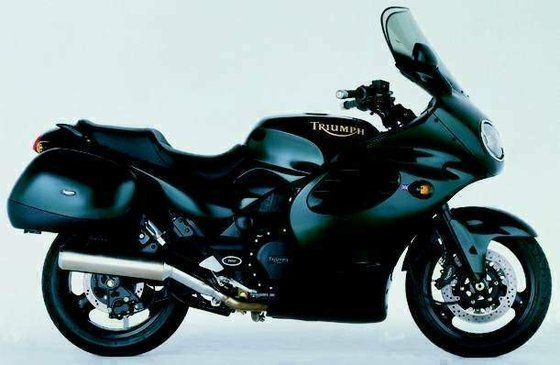
In the late ’90s, the Trophy 1200 faced fierce rivals. Here’s how it measures up:
1. Honda ST1100
- Pros: Shaft drive, bulletproof reliability.
- Cons: Heavier (608 lbs wet), less power (100 HP).
- Verdict: The Honda is a workhorse, but the Trophy’s engine is livelier and more engaging.
2. Kawasaki GTR1000 (Concours)
- Pros: Affordable, shaft-driven.
- Cons: Carbureted (until 1994), dated styling.
- Verdict: The Kawasaki prioritizes function over flair; the Trophy feels more premium.
3. BMW R1100RT
- Pros: Telelever front suspension, iconic BMW build quality.
- Cons: Boxer engine vibes, complex maintenance.
- Verdict: The BMW excels on rough roads, but the Trophy’s inline-four is smoother for long hauls.
The Trophy’s chain drive is a sticking point against these shaft-driven competitors, but its power-to-weight ratio (0.46 HP/kg) and visceral engine character set it apart.
Maintenance: Keeping the Trophy Thriving

Owning a 20-year-old motorcycle requires diligence. Here’s what to prioritize:
1. Engine Care
- Oil Changes: Use 10W-40 synthetic every 3,000–5,000 miles (4,800–8,000 km). The wet sump holds 3.5 liters.
- Valve Adjustments: Every 16,000 km (10,000 miles). Intake valves: 0.10–0.15 mm, exhaust: 0.15–0.20 mm (cold).
- Carb Sync: Crucial for smooth idle. DIY with vacuum gauges or leave it to a pro.
2. Chain Maintenance
- Lubrication: Clean and lube every 500 miles (800 km). The 112-link chain wears faster than a shaft but is cheaper to replace.
- Sprockets: Stock 18/45 gearing works well, but a 17-tooth front sprocket improves acceleration.
3. Cooling System
- Coolant Flush: Replace every 2 years with ethylene glycol-based coolant (3-liter capacity).
- Hose Inspection: Aging rubber can crack—upgrade to silicone hoses for longevity.
4. Brakes
- Fluid: DOT 4, changed biannually.
- Pads: Swap in sintered pads for better bite.
MOTOPARTS.store Recommendations:
- Upgraded Windscreen: Reduce buffeting with a taller, wider screen.
- Heated Grips: Essential for chilly mornings.
- Aftermarket Seat: Cure the stock seat’s narrow profile with a gel or memory foam option.
Final Thoughts
The Triumph Trophy 1200 is a testament to an era when touring bikes balanced sportiness and comfort without relying on electronic aids. Its inline-four engine remains a jewel, offering turbine-like smoothness and ample torque for real-world riding. While it lacks modern conveniences like traction control or ride modes, its mechanical purity is part of its charm.
For owners, maintaining this classic is a labor of love—one rewarded by every mile of open road. And for those looking to enhance their Trophy, MOTOPARTS.store offers everything from performance upgrades to creature comforts, ensuring this British icon continues to turn heads and conquer horizons.
Specifications sheet
| Engine | |
|---|---|
| Stroke: | Four-stroke |
| Max power: | 79 kW | 106.0 hp |
| Max torque: | 104 Nm |
| Fuel system: | 4 x 36 mm Flat side CV carburetors |
| Lubrication: | Wet sump |
| Max power @: | 9000 rpm |
| Spark plugs: | NGK DPR8EA-9 |
| Displacement: | 1180 ccm |
| Max torque @: | 5000 rpm |
| Configuration: | Inline |
| Cooling system: | Liquid |
| Spark plug gap: | 0.9 |
| Compression ratio: | 10.6:1 |
| Number of cylinders: | 4 |
| Dimensions | |
|---|---|
| Wheelbase: | 1490 mm (58.7 in) |
| Dry weight: | 235 |
| Seat height: | 790 mm (31.1 in) |
| Overall width: | 790 mm (31.1 in) |
| Overall height: | 1430 mm (56.3 in) |
| Overall length: | 2152 mm (84.7 in) |
| Fuel tank capacity: | 25 L (6.6 US gal) |
| Drivetrain | |
|---|---|
| Clutch: | Wet, multiple discs, cable-operated |
| Final drive: | chain |
| Chain length: | 112 |
| Transmission: | 6-speed |
| Rear sprocket: | 45 |
| Front sprocket: | 18 |
| Maintenance | |
|---|---|
| Engine oil: | 10W40 |
| Idle speed: | 1000 ± 50 RPM |
| Brake fluid: | DOT 4 |
| Coolant capacity: | 3.0 |
| Forks oil capacity: | 1.172 |
| Engine oil capacity: | 3.5 |
| Engine oil change interval: | Every 5000 km or 2 years |
| Valve clearance (intake, cold): | 0.10–0.15 mm |
| Valve clearance check interval: | 24,000 km |
| Valve clearance (exhaust, cold): | 0.15–0.20 mm |
| Recommended tire pressure (rear): | 2.9 bar (42 psi) |
| Recommended tire pressure (front): | 2.5 bar (36 psi) |
| Chassis and Suspension | |
|---|---|
| Rake: | 27° |
| Frame: | Steel trellis |
| Trail: | 105 mm (4.1 in) |
| Rear tire: | 170/60 z-17 |
| Front tire: | 120/70 z-17 |
| Rear brakes: | Single 255 mm disc, 2-piston caliper |
| Front brakes: | 2 x 310 mm discs, 4-piston calipers |
| Rear suspension: | Monoshock, adjustable preload and rebound damping |
| Front suspension: | 43mm telescopic fork, adjustable compression, rebound damping, and spring preload |



